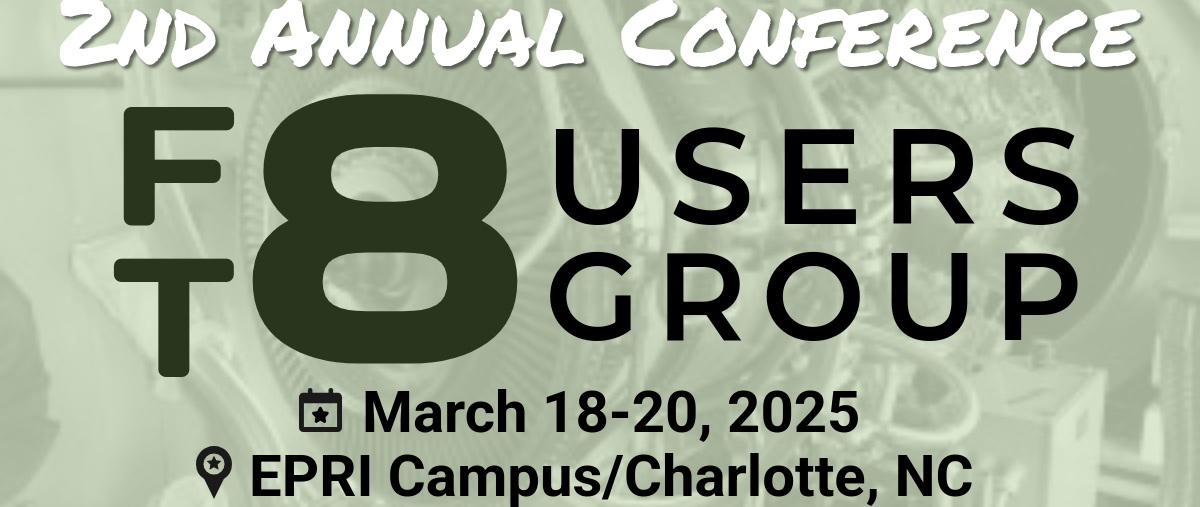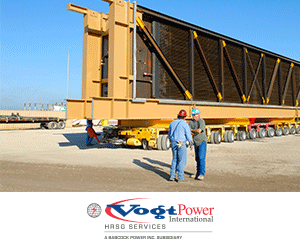The first meeting of the FT8 Users Group took place on March 12-14, 2024, at EPRI’s Washington DC office with the purpose of sharing collective expertise of end-users, consultants, and third-party suppliers in addressing the complexities of Mitsubishi Power Aero’s (formerly Pratt & Whitney Power Systems) FT8 gas turbine operation and maintenance. The group is set to meet for its second soiree from March 18-20 in Charlotte, where users can attend at no charge. The contents of this report on the 2024 inaugural meeting are as follows:
- Setting the stage with EPRI’s Noble
- Key issues facing the aging fleet
- O&M limitations
- Anatomy of a controls upgrade
- Not all who wander are lost
- FT8 solutions providers showcase deep experience
- Ask the experts
- What’s in store?
2025 Steering Committee
Ramiro Gonzalez, plant manager, NAES Corp
Ahmed Ibrahim, director of operations, Middle River Power
George Shambo, plant manager, NVEnergy
Shawn Fowler, independent consultant
Richard Carter, director, Global Turbine Support
Attendance was impressive with 40 end users responsible for a large percentage of the operating fleet and over 20 companies focused on solutions for FT8-powered facilities (Sidebar). By pooling knowledge and leveraging shared experiences, the group dynamic fosters open dialogue, allowing users and vendors to share experiences and collaboratively develop solutions.
The group’s collaborative discussion forum, accessible at forum.ft8users.com, was lauded by users as a valuable tool for sharing insights, troubleshooting advice, and solutions to shared challenges. Case in point: the presentations referenced in this recap are available for download to registered users. Register for this free service if you are an end user of FT8 engines.
Setting the stage
The keynote presentation by EPRI’s Bobby Noble delved into the evolving global energy landscape, highlighting the transformative role of gas turbines in the energy transition. Addressing a “perfect storm” of challenges and opportunities, Noble underscores the necessity of collaboration, innovation, and a balanced approach to achieve decarbonization goals.
The energy sector is rapidly transforming as global efforts prioritize reducing carbon emissions and adopting low-carbon technologies. Since the early 2000s, the transition from coal to cleaner fuels like natural gas and the integration of renewable energy sources have driven significant progress. By 2050, most countries aim to achieve net-zero emissions, though substantial infrastructure and technological gaps must be addressed to meet these ambitious targets.
Gas turbines are positioned as essential enablers of this transition, offering flexibility, resilience, and cost-effective solutions. Advances in low-carbon fuel technologies, such as hydrogen compatibility and carbon capture and storage (CCS) systems, enable gas turbines to complement renewable energy sources, ensuring reliability and grid stability.
Despite these innovations, challenges remain, including the developmental stage of advanced energy storage and hydrogen production technologies. Accelerating the energy transition without fully mature solutions risks reliability issues, emphasizing the importance of strategic deployment and robust infrastructure development (Fig 1).
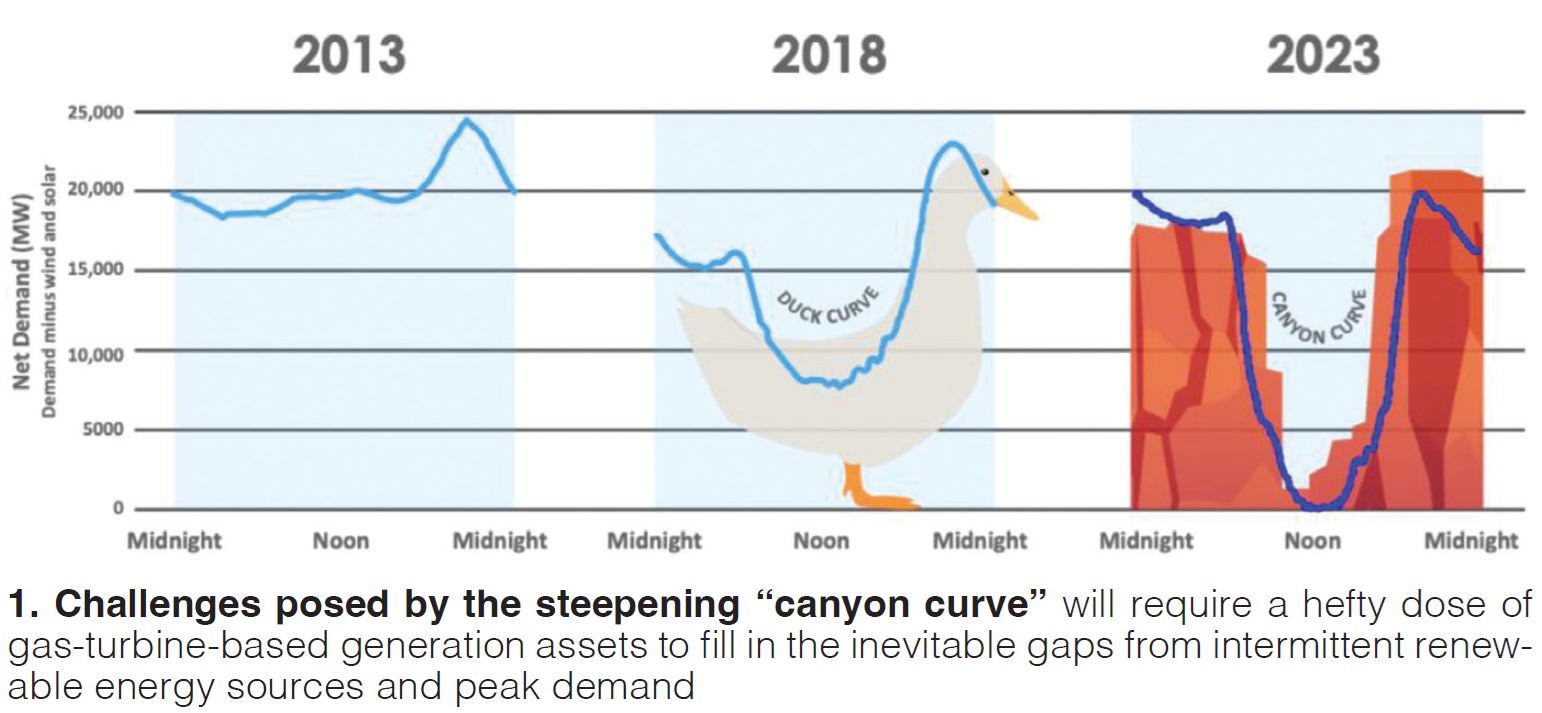
Noble called for the electric sector to lead decarbonization efforts through global collaboration and phased integration of emerging technologies. This approach will facilitate a sustainable energy future by balancing innovation with strategic planning.
Key issues facing this aging fleet
Much of the discussion over the three days highlighted key operational and maintenance challenges while emphasizing the value of collaboration among users. One recurring theme was the inconsistent performance of FT8 units, even under similar conditions. This variability underscored the importance of standardized maintenance practices and detailed diagnostics.
Attendees emphasized the need for proactive maintenance, open collaboration, and adaptation to the evolving demands of FT8 operations, particularly in the context of renewable energy integration. By implementing these measures, users can enhance unit reliability, reduce costly downtime, and address recurring challenges effectively. The user group’s efforts to share knowledge and advocate for improved practices are vital to achieving these goals and ensuring the long-term fleet performance.
Components like thermocouples and exhaust gas temperature (EGT) sensors emerged as critical to turbine performance but were also frequent points of failure, necessitating careful monitoring and timely replacement.
No surprise to anyone in the gas turbine industry, the group identified challenges related to sourcing and maintaining specific components. Replacement parts, such as cold air buffers and thermocouples, often had long lead times and high costs, which complicated maintenance schedules.
Some participants explored third-party alternatives, like Conax Technologies, which demonstrated improved reliability in certain cases. Additionally, innovative repair strategies, such as creating custom wiring harnesses, were discussed to reduce dependency on the OEM.
Upgrades to control systems sparked mixed reactions among the participants. While some facilities benefitted from enhanced functionality, others faced difficulties integrating new systems and troubleshooting issues. This highlighted the importance of tailoring upgrades to the specific operational needs of each facility.
Training and knowledge sharing were emphasized as vital to effective turbine maintenance. Ensuring that operators and maintenance teams understand key aspects of FT8 systems, such as thermocouple positioning and calibration, was deemed essential for consistent performance.
FT8 gas turbines have experienced several recurring issues over the years, particularly in bearings, compressors, combustion systems, and synchronous condensing operations. Among these, bearing failures have been a consistent concern.
Carbon oil seals and bearings often fail due to wear, leakage, and coking, which block oil flow and cause severe damage (Fig 2). Insufficient lubrication during synchronous condensing is a major contributor to catastrophic failures such as rotor lock-ups. To mitigate these issues, users were advised to replace carbon oil seals and bearings during hot section inspections and improve oil monitoring systems to detect anomalies early.
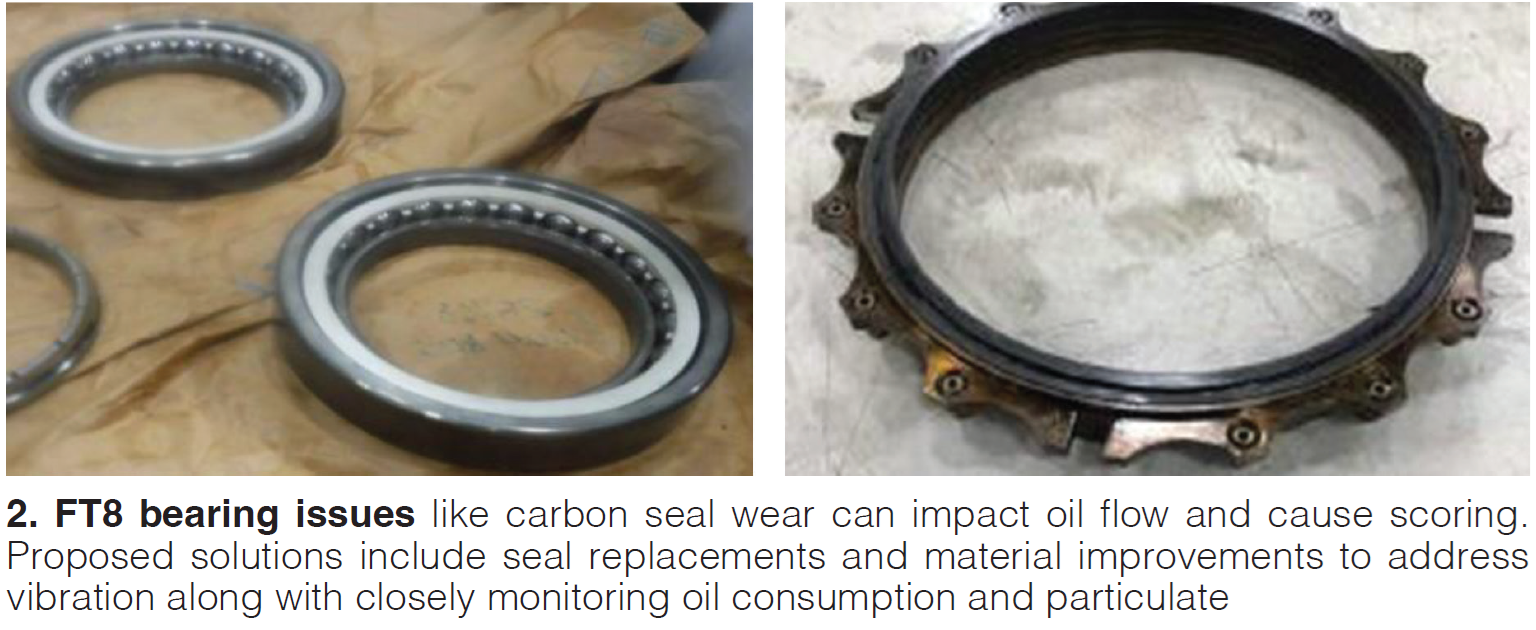
Compressor-related problems were also prominent, with inlet icing, airfoil fatigue, and blade failures in stages 8 and 9 being common. These issues often result from vibration and fatigue. To address these, regular maintenance practices such as testing solenoid valves, performing thorough borescope inspections, and implementing strict policies after surge events were recommended.
In the combustion system, challenges such as gang channel rivet loosening, combustion chamber mounting pin liberation, and bolt failures frequently caused consequential damage downstream. Proactively upgrading components, adhering to OEM recommendations, and replacing worn parts during inspections were deemed essential to minimize these risks.
Synchronous condensing, increasingly utilized due to the growing adoption of renewable energy, presents additional challenges. This operational mode often led to significant wear on the gas generator because of inadequate lubrication and overheating during windmilling.
High-severity failures, including rotor lock-ups and downstream damage, were reported. Recommendations included modifying units with SSS clutches, installing supplemental lubrication systems, and conducting regular maintenance to ensure reliable operation.
O&M limitations
FT8 gas turbines are well-suited for frequent starts and stops, but they struggle under conditions requiring rapid load changes or load-following capabilities. Such operations exert excessive wear on bearings and rotors, adversely affecting reliability.
Users noted that the current maintenance schedule, based on a fixed 25,000-hour interval for hot section inspections, is outdated and unsuitable for plants operating in peaking or cyclic modes and advocated for maintenance schedules based on operational cycles rather than hours to reflect the real stresses experienced by these units.
Rotor and tie-rod failures emerged as a particularly severe issue. Overheating and insufficient lubrication during synchronous condensing led to tie rod failures, rotor misalignment, and blade damage, often requiring complete overhauls. These failures highlighted the importance of adapting maintenance practices to the operational demands of modern FT8 usage.
Proactive recommendations proposed to address these challenges included:
- Collaborate with OEM to update maintenance practices, improve material designs, and resolve component limitations.
- Proactively replace critical components such as carbon oil seals, bearings, and gang channel rivets during inspections.
- Modify units to improve compatibility with synchronous condensing, including installing SSS clutches and enhancing lubrication systems.
- Monitor vibration, oil consumption, and chip detector alarms closely to detect early signs of failure.
- Align maintenance schedules with the operational realities of peaking and cyclic operations, rather than relying on fixed-hour thresholds.
Anatomy of a controls upgrade
One of the highlights of the user session, illustrating to those reading the true value of attending, was a presentation from an owner/operator with over two dozen engines which outlines the process and outcomes of upgrades to control systems, automatic voltage regulators (AVR), and SEL synchronizers. The slides provide a comprehensive look at the pre-installation, installation, and post-installation phases, highlighting both successes and challenges.
The controls upgrade began with a straightforward pre-installation process, including scope definition, material acquisition, and contractor coordination. Delays in acquiring materials required custom-made Micronet cables to ensure readiness. Installation, initially planned for 12 weeks, was completed more efficiently, with the time required per unit dropping from 14 days for the first unit to 7 days for the last.
The upgrade involved system backups, hardware enhancements to processors and communication modules, and software updates from GAP 3.0 to GAP 4.0, along with functional and operational testing. Post-installation, the upgraded systems demonstrated faster, more reliable performance and improved visibility into system functionalities. However, wire management remained tedious, complicating maintenance.
AVR/synchronizer upgrade also faced logistical hurdles during pre-installation, including equipment verification and material delays. Despite an initial schedule of 37 days, the installation was completed in 14 days due to increased efficiency. Major upgrades included replacing the Brush A30 AVR with the Brush A3100 and upgrading the synchronizer to the SEL 700G.
Challenges arose with relay functionality, communication issues, and wiring complexities introduced by the new AVR’s dual communication runs. Post-installation, the systems displayed enhanced functionality, more refined control steps, and better visibility through the Brush HMI and software.
However, lingering issues such as CITECT command oddities, relay wiring errors, and compliance challenges with NERC standards required further attention. Unit 2’s AVR faced manufacturing defects, which led to warranty claims and delays in obtaining replacements.
Overall, the upgrades significantly improved system performance and reliability but highlighted challenges with material delays, compliance requirements, and post-installation troubleshooting. These experiences provide valuable lessons for future upgrades, showcasing the importance of meticulous planning and adaptability.
2024 FT8 Solutions Providers |
|
| Advanced Turbine Support AGTServices Baseload Power Camfil Power Systems Dekomte de Temple Donaldson Electric Machinery – WEG Freudenberg Filtration Technologies GasTops Global Turbine Support |
Groome Industrial Service Group HPI Energy Services KDN Global Gas Turbine Support Liburdi Turbine Services National Electric Coil SJ Turbine Sulzer Turbo Services Van Hydraulics VAW Systems Woodward |
Not all who wander are lost
Power industry consultant Campbell Archibald eloquently reflected on the evolution and growing significance of independent support services in the gas turbine industry. Drawing from decades of experience, Archibald shared his journey from an apprentice in 1989 to his leadership role at Alba Power, illustrating a career dedicated to advancing turbine support and repair services. Now, he advises companies such as Liburdi Turbine Services and HPI Energy Services to better position themselves for aftermarket MRO opportunities.
The speaker touted the advantages of independent service providers over traditional (oft-degrading) OEM aftermarket support. Trust forms the foundation of these relationships, enabling clear, client-aligned objectives and consistent over-delivery of results. Independent providers excel in offering comprehensive solutions tailored to the unique needs of entire stations, fostering deep collaboration and delivering measurable benefits in cost, efficiency, and reliability.
The principles for successful independent support are steeped in building trust, understanding client needs, and delivering holistic station support. These strategies strengthen long-term partnerships and ensure high-quality service. A case study of collaboration between FT8 users and Liburdi detailed later in this article exemplifies the impact of innovative problem-solving and effective partnerships.
To close, Archibald emphasized the transformative potential of trust-based partnerships, showcasing the pivotal role of independent service providers in shaping the future of the energy industry, perfectly teeing it up for the ten presenting companies, outlined below, focused on the FT8 aftermarket.
FT8 solutions providers showcase deep experience
AGTServices
Industry veteran Jamie Clark, in his classic style, emphasized the critical importance of thorough and expert-driven generator testing and inspection processes to ensure reliability and prevent costly failures.
Experienced specialists are irreplaceable in identifying issues and stresses the value of leaving visible clues, like dirt, untouched during initial inspections to uncover diagnostic insights. A clear message is that there are no shortcuts in generator maintenance—speed and extended intervals between inspections often compromise quality and reliability.
Early detection of potential issues to avoid serious damage ensure confidence in the generator’s performance and planning future upgrades or repairs. A variety of tests, including electrical, mechanical, and visual inspections, are essential components of this proactive approach.
Specific electrical tests such as winding resistance (Fig 3) and insulation resistance are critical for diagnosing imbalances, contamination, or damage, while advanced methods like DC leakage tests and polarization index measurements provide deeper insights into insulation health and failure risks.
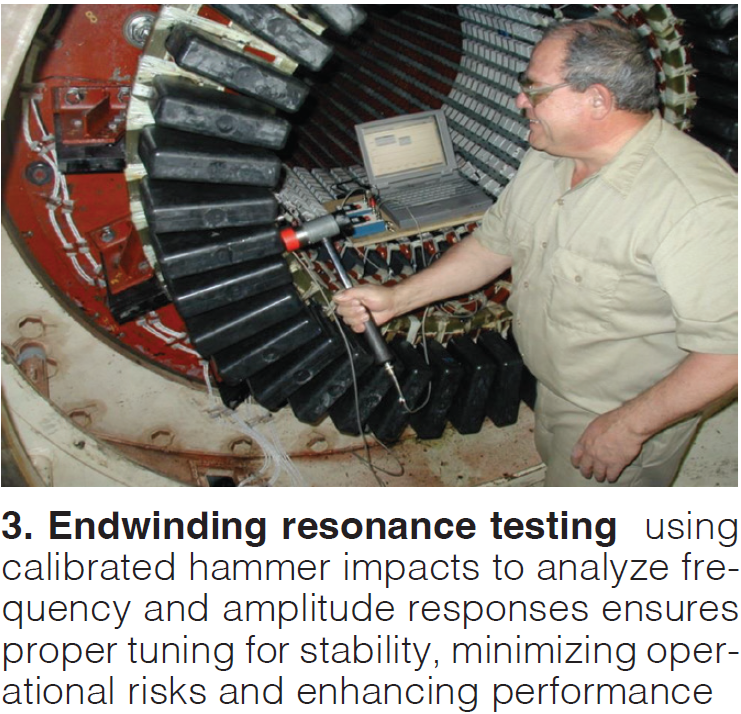
Clark expounded on the value of advanced diagnostic tools, such as the EL CID for identifying lamination shorts and end-winding resonance tests for optimizing stability. Techniques like robotic inspections, surge tests, and acoustic surveys represent evolving technologies improving reliability and detection precision.
Key takeaways include the necessity of addressing identified issues promptly through actions like cleaning, soldering, or reassembly to maintain generator integrity. Examples of good and bad test results emphasize the importance of diagnostic accuracy and corrective actions.
Ultimately, this very detailed slide deck serves as a reminder that diligent and well-executed testing is indispensable for generator reliability. It advocates for a meticulous approach, avoiding shortcuts, and leveraging expertise and advanced technologies to ensure sustainable and cost-effective operation.
GasTops
Simon Wilson and Zachary Reesor present compelling case studies on company’s renowned MetalSCAN Oil Debris Monitoring System, highlighting its innovative approach to monitoring critical rotating components. MetalSCAN addresses the limitations of traditional methods by offering 100% detection of metallic debris and precise particle classification, enabling early damage identification and risk mitigation.
Features such as real-time monitoring, remaining useful life prediction, and maintenance-free operation allow operators to plan maintenance effectively, reducing costs and downtime. Case studies illustrate MetalSCAN’s success in proactive maintenance, avoiding secondary damage, and ensuring operational continuity (Fig 4).
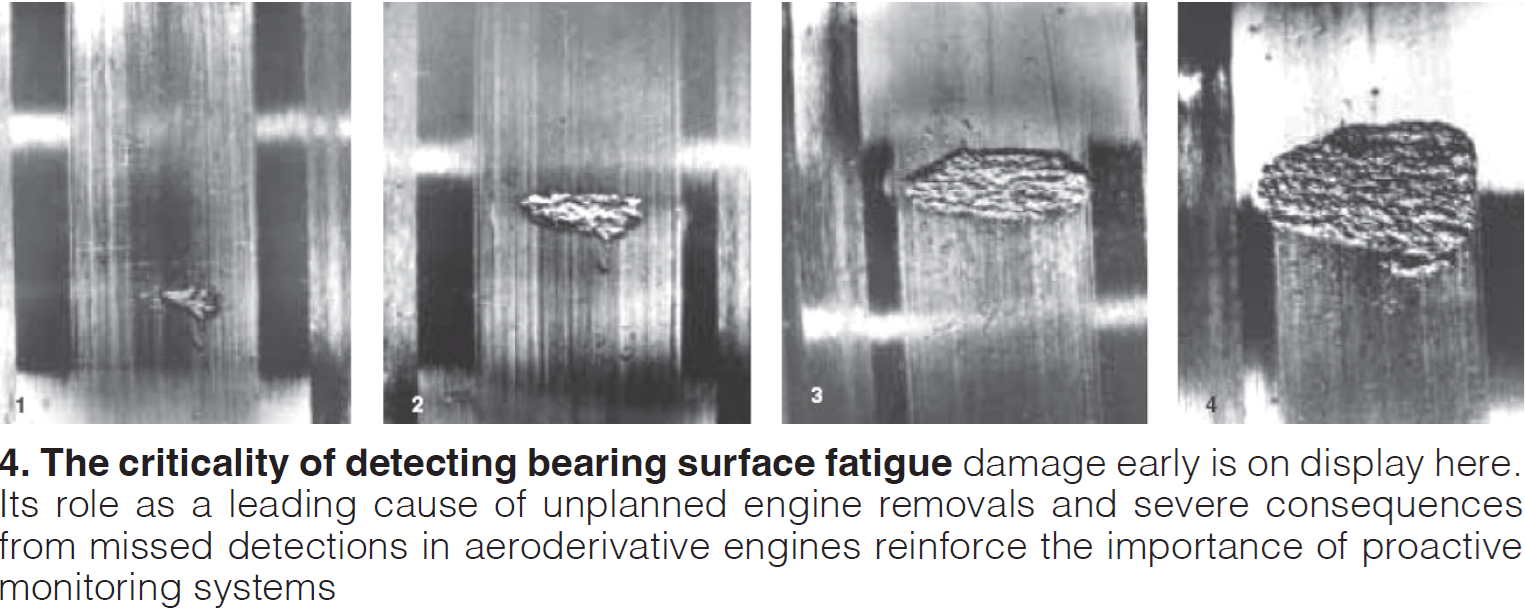
GasTops combines monitoring technology with laboratory services, providing detailed analysis to enhance diagnostics and decision-making. This integrated approach significantly improves equipment reliability and efficiency.
Groome Industrial Service Group
Matt Cohen, technical sales lead, emphasized catalyst cleaning and lifecycle management’s critical role in maintaining industrial system efficiency. Groome specializes in services like HRSG tube cleaning, SCR catalyst maintenance, and CO catalyst washing. Key factors impacting performance include non-uniform gas flow, temperature variations, and catalyst deterioration caused by fouling, poisoning, and structural damage (Fig 5).
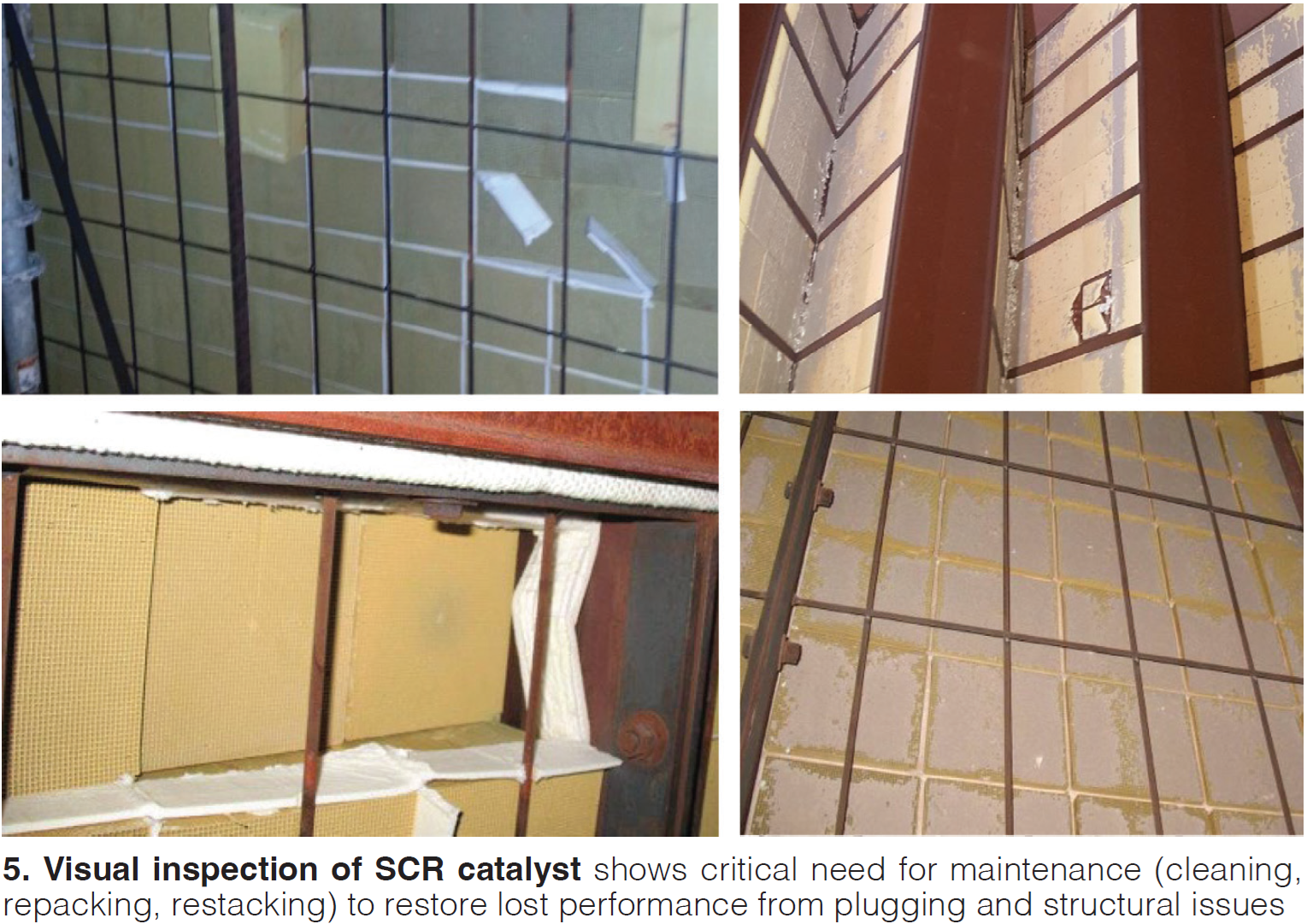
Groome’s maintenance programs address these challenges through advanced cleaning techniques and system optimization. For CO catalyst systems, methods like acid washing and gasket retention improve backpressure and extend component life, while AIG cleaning and tuning ensure precise ammonia distribution to enhance SCR performance.
Cohen stresses the importance of regular catalyst testing and system analysis. Testing enables the identification of catalyst versus system problems, guiding corrective actions and preventing costly downtime. By integrating visual inspections, operating data analysis, and sample testing, Groome provides a comprehensive evaluation of system performance.
The financial impact of maintenance was shown in a case study of an ethylene plant that achieved a nine-day payback period through catalyst cleaning, significantly boosting daily revenue. Additionally, the cost of pressure drops across turbines is quantified, showcasing the economic benefits of maintaining optimal system conditions.
Ultimately, proper catalyst maintenance and lifecycle management ensures improved performance, reduced operational costs, and extended system life.
KDN Global Gas Turbine Support
Company namesake Karel de Nave emphasizes its comprehensive capabilities in supporting gas turbine operations, including field services, parts supply, equipment retrofits, troubleshooting, design improvements, and training. KDN positions itself as a reliable partner for customers requiring advanced technical solutions and lifecycle management of turbine systems.
Key offerings include annual inspections, borescope evaluations, preventive maintenance recommendations, and retrofitting mechanical and control systems. KDN’s expertise extends to disassembly and assembly of components such as GG, PT, combustion chambers, and fuel nozzles. By implementing OEM service bulletins and performing critical alignments and repairs, the company ensures optimized equipment performance.
Retrofit projects, such as the installation of offline water injection systems and collector box seal replacements (Fig 6), highlight KDN’s innovative approach to enhancing turbine efficiency and reliability. The offline water injection system improves maintenance accessibility, reduces costs, and enhances emission control.
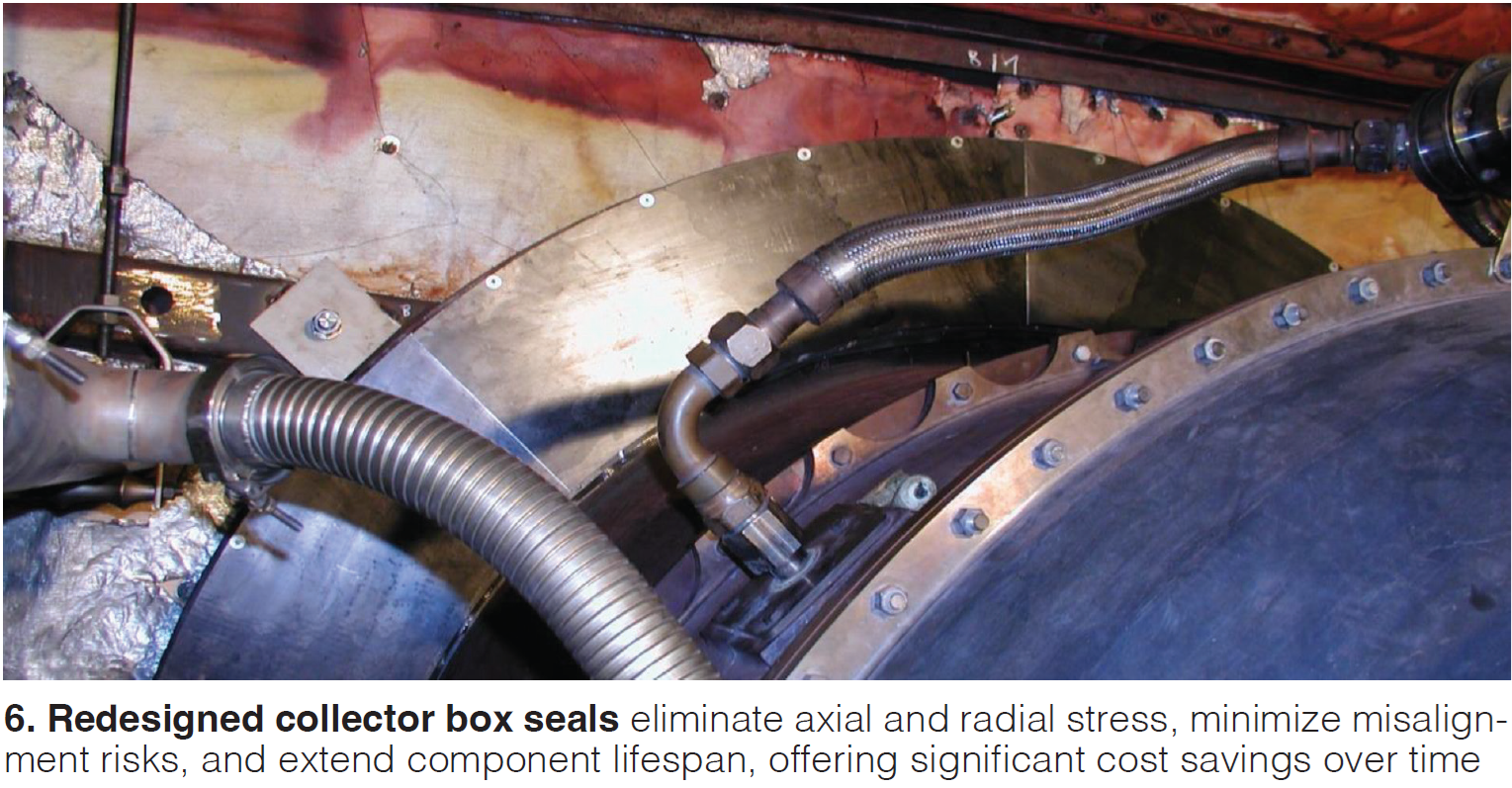
KDN’s spare parts and repair capabilities further support its commitment to operational efficiency. The company provides components like hydraulic starter motors, combustion chambers, and fuel nozzles, while offering repair services for critical parts, reducing downtime and costs.
Case studies demonstrate the success of KDN’s solutions, such as projects in Germany and Romania where retrofitted systems achieved long-term operational benefits. The company’s focus on reliability, cost-effectiveness, and tailored customer support ensures its solutions meet diverse industry needs.
Through a combination of expertise, innovation, and commitment to customer success, KDN delivers high-value services to optimize the performance and longevity of gas turbine systems globally.
Liburdi Turbine Services
Jeff Chapin, business development manager, and former plant manager Shawn Fowler updated attendees on advanced solutions for repairing and optimizing FT8-3 dual-fuel nozzles, addressing challenges related to fuel system backflow and component failures.
Liburdi, a leading provider of turbine component repair services since 1979, supports industries like oil and gas, power generation, and aerospace with cost-effective maintenance and repair strategies.
Of great interest to end usersis the issue of liquid fuel backflow into the gas supply system, causing coking and blockages in nozzles, headers, and hoses. Testing revealed that internal stress cracks within fuel nozzles allowed cross-talk between liquid and gas flow paths, exacerbating the problem. Early indicators showed localized coking in specific nozzles, with further testing demonstrating that rebuilt nozzles often failed within short operational timeframes.
To address these issues, Liburdi developed advanced repair processes. The repair strategy includes rigorous inspections, material verification, cleaning, dimensional assessments, and application of wear-resistant coatings (Fig 7). For severely damaged nozzles, advanced techniques such as weld repair of internal housing cracks and reassembly ensure leak-free operation. This approach significantly extends nozzle life and mitigates failure risks.
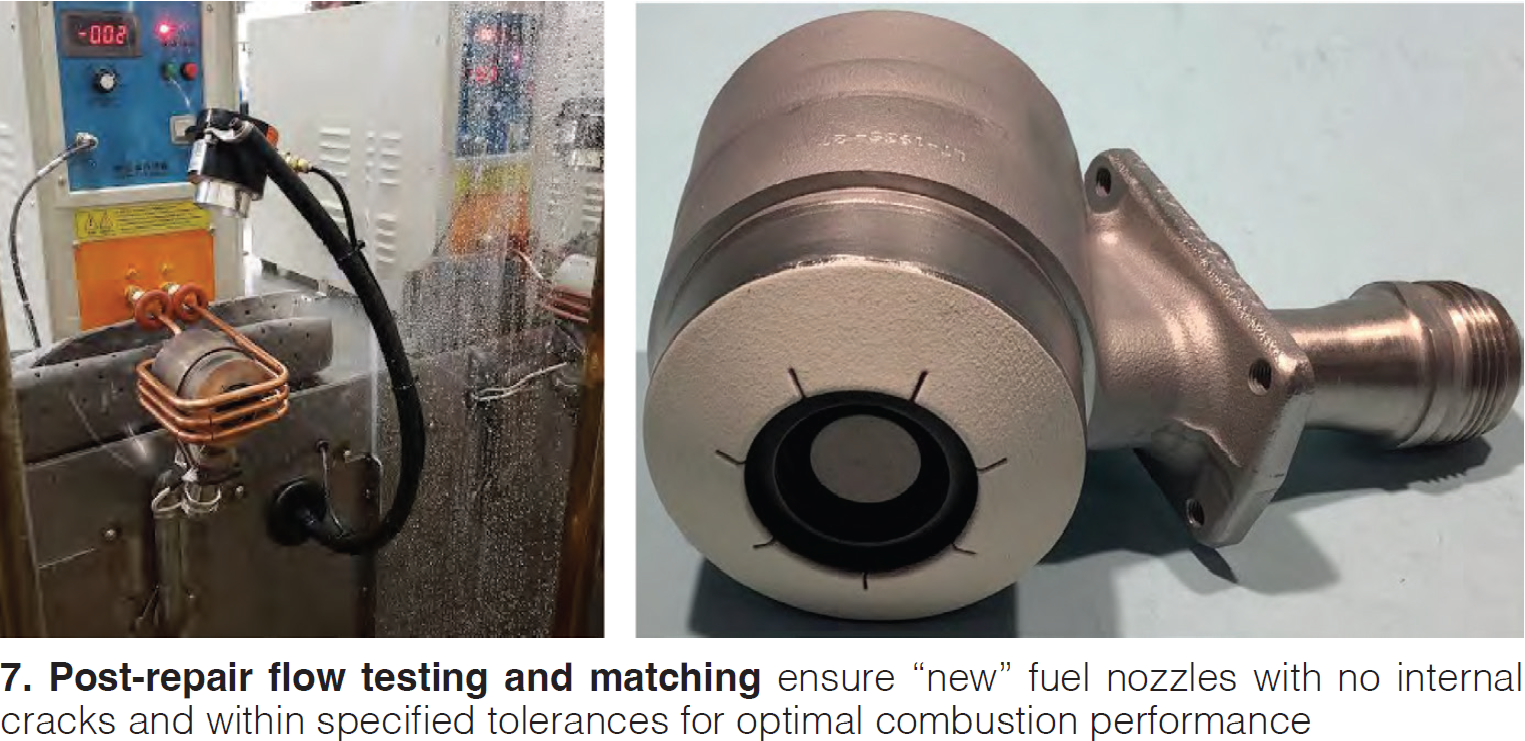
Liburdi’s solutions also emphasize cost savings. Repairs typically cost 25%-30% of replacement parts, providing significant financial advantages. Root cause analysis and redesigned components further enhance reliability, reducing maintenance cycles and operational disruptions.
The presentation highlights successful implementation of new and repaired nozzles in 16 of 24 engines at one particular site, with operational tests confirming the effectiveness of these interventions. By combining technical expertise, rigorous testing, and innovative repair solutions, Liburdi supports customers in maximizing turbine efficiency, minimizing downtime, and extending component life.
National Electric Coil (NEC)
Generator guru Howard Moudy addressed critical concerns and solutions for FT8-applied generators, emphasizing contamination, partial discharge, rotor and stator maintenance, and tailored repair methodologies. As a global leader with over a century of experience in generator technology, NEC focuses on quality, performance optimization, and longevity.
Key challenges highlighted include contamination from operational environments and aging systems, leading to issues such as partial discharge, corona damage, and cooling inefficiencies. NEC employs advanced cleaning methods like CO2 cleaning to safely remove contaminants without damaging components. For partial discharge and corona concerns, NEC leverages IEEE standards and engineered solutions to mitigate damage and improve insulation longevity.
The presentation features case studies illustrating common issues and their resolutions. For example, rotor challenges such as magnetic retaining ring stress corrosion cracking (Fig 8) and tooth-top fatigue are addressed through advanced engineering solutions like replacing fabricated assemblies with solid billets and implementing new retaining ring designs.
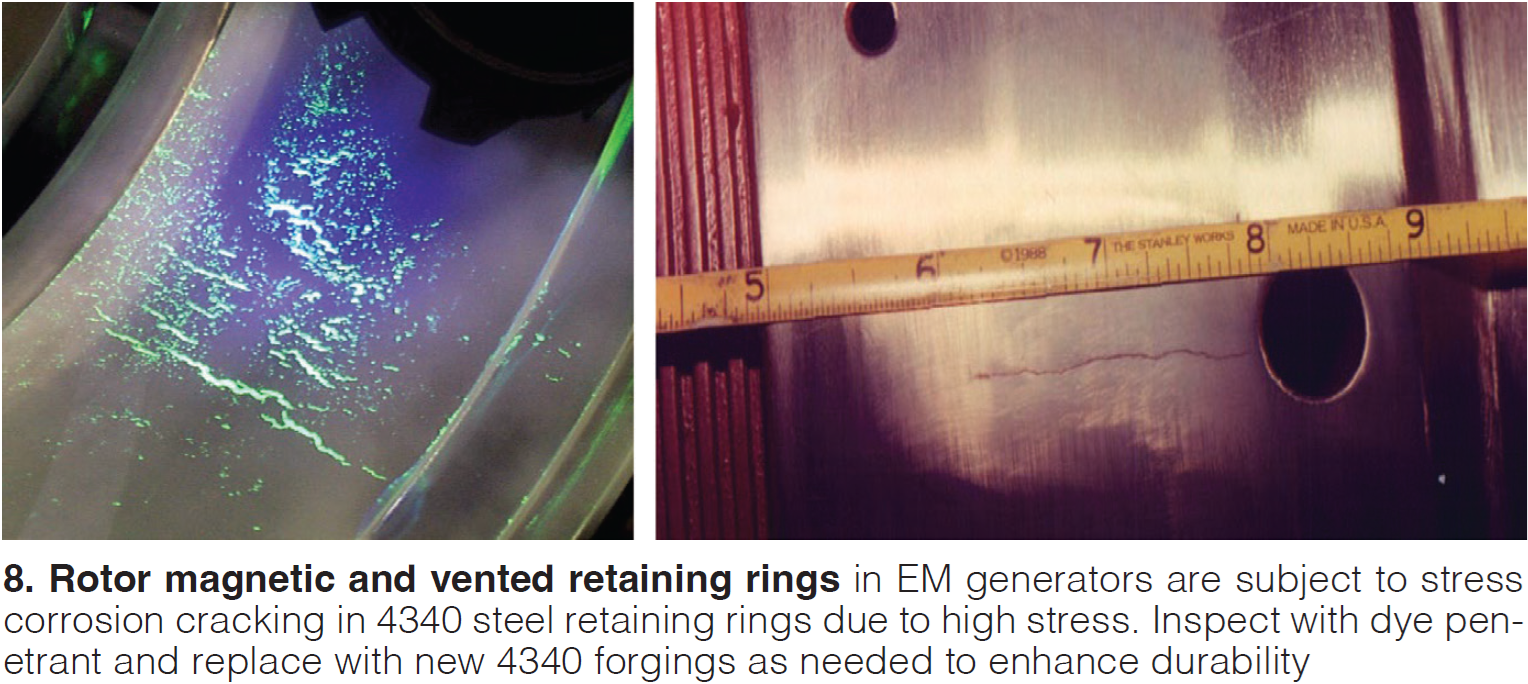
Stator issues, such as coil damage and end-winding failures, are tackled using tailored repairs involving high-quality replacement coils, outer corona protection systems, and slot-side packing upgrades.
Through innovative approaches and proven expertise, NEC enhances generator reliability, reduces maintenance costs, and extends service life. The presentation underscores NEC’s commitment to delivering world-class solutions for generator repair, maintenance, and component manufacturing, solidifying its position as a trusted partner in the power generation industry.
Sulzer Turbo Services
Matt Walton, gas turbine metallurgy and repair expert, highlighted the company’s ongoing efforts to provide extensive maintenance capabilities for FT8 users, including depot-level services, component repairs, and reverse engineering (Fig 9). These developments, unknown to many attendees, were met with great interest and excitement, spurring a valuable exchange of ideas, suggestions, and ambitions.
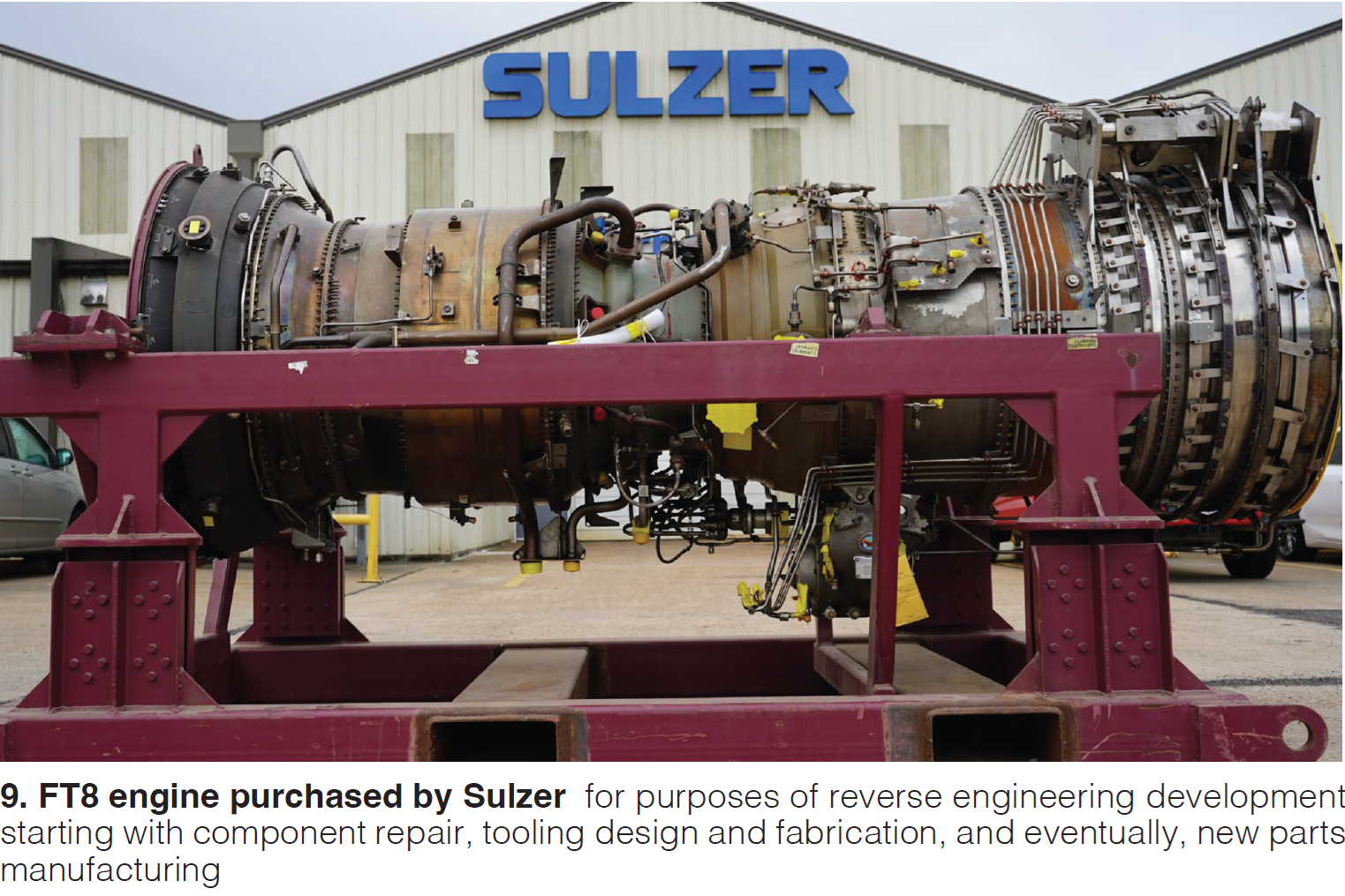
Sulzer’s field service team, with a long history of aeroderivative expertise, offers borescope inspections, module swaps, installations, commissioning, and troubleshooting. While describing this group dedicated to specialty aeroderivative field work, Walton reiterated their commitment to this market, “If you want to be in an engine, you have to be in the engine all the way.”
The company’s service roadmap includes ongoing development of reverse engineering capabilities, heat treatment validation, coating advancements, and the production of new parts like gas generator components and bearings.
A key focus is Sulzer’s ability to reduce turnaround times and costs for depot-level services. By integrating reverse engineering and precision manufacturing, Sulzer addresses issues of OEM scrap, financial inefficiencies, and delayed service delivery. Walton invited users to engage in shaping Sulzer’s offerings, highlighting a collaborative approach to better serve the FT8 community.
Baseload Power
Bob Vandenable’s presentation on Baseload Power focuses on the company’s expertise in aeroderivative gas turbines and its comprehensive inspection and repair services. Emphasizing adherence to ISO 9001 quality standards, Baseload Power delivers specialized support across various operational domains, ensuring effective turbine management.
Key services include interval-based inspections, from 8,000 to 100,000 operational hours, tailored for turbines like the FT8, LMS100, LM6000, and LM2500 series. Maintenance processes such as generator field inspections, retaining ring reassembly, and exciter armature repairs highlight the company’s precision and thoroughness. Advanced diagnostic methods, including borescope evaluations and high-potential testing, ensure component reliability.
Baseload Power integrates cutting-edge tools and rigorous quality standards, positioning itself as a trusted partner in enhancing aeroderivative gas turbine performance through innovation and expertise.
HPI Energy Services
Wayne Tomlinson, senior GT specialist, introduced its ARMADA remote monitoring system, showcasing advanced capabilities in reliability-centered maintenance. Built for scalability, ARMADA offers real-time diagnostics for gas turbines, steam turbines, and diesel generators, combining high-speed data gathering with advanced analytics such as vibration and oil debris monitoring.
ARMADA’s cybersecurity features, including ISO-27001 compliance, ensure secure client connections. Early issue detection minimizes downtime, reduces costs, and enables precise maintenance scheduling. A case study demonstrates ARMADA’s effectiveness in optimizing maintenance schedules, reducing lost revenue, and limiting equipment damage.
HPI integrates root cause analysis with advanced monitoring technologies, transitioning clients from reactive to proactive maintenance strategies. This approach enhances reliability, operational efficiency, and overall asset performance.
Woodward
Brooks Hoffman, sales manager, featured the company’s longstanding expertise in energy control solutions across aerospace and industrial sectors. Advancements in control systems, such as the MicroNet Plus platform, enhance reliability and support energy transition technologies.
The presentation details advancements in Woodward’s control systems, including the evolution from the NetCon platform to the current MicroNet Plus system, which offers superior performance and redundancy for critical applications.
For products facing phased obsolescence like the LON LinkNet and 3103 Fuel Metering Valve, Woodward has introduced replacements such as the rugged LINKnet-HT modules and GS40/GS50 valves. These upgrades enhance reliability, performance, and compatibility, with the GS50 valves supporting hydrogen-methane blends up to 50% and 100% hydrogen-compatible options.
Ask the experts
The Ask the Experts panel at the 2024 FT8 Users Group provided valuable insights into operational challenges and maintenance strategies for aeroderivative gas turbines. Panelists, who were experts in areas such as hot section inspections, generator maintenance, advanced repairs, and control systems, made themselves available to end users for two hours of Q&A to close out the conference. Thought leaders included:
- Dave Budreau, Power Control Services and Electric
- Richard Carter, Global Turbine Support
- Bob Tollet, Liburdi Turbine Services
- Karel de Nave, KDN Global Gas Turbine Support
- Jamie Clark, AGTServices
- Ahmed Ibrahim, Middle River Power
One key area of discussion was varnishing issues in turbine oil systems, caused by high temperatures, contamination, and frequent cycling. Recommendations included monthly oil sampling, advanced filtration techniques, and using high-quality lubricants like Mobil Jet II. Additionally, panelists emphasized proactive measures such as employing varnish mitigation systems and maintaining clean oil supplies.
Servo valve failures were another critical topic, with panelists identifying varnishing and contamination as primary causes. Solutions included recalibration, preventive maintenance, and improvements in hydraulic system design to enhance reliability.
Challenges during start-up and shut-down procedures were highlighted, particularly with lean fuel mixtures leading to ignition failures. Adjustments to tuning blocks, minimum stops, and start-up fuel rates were proposed as effective remedies, alongside seasonal tuning strategies to ensure consistent performance.
The panel also addressed single crystal blade repairs, emphasizing that these components are repairable but require careful evaluation of stress points and repair locations. Finite element analysis (FEA) and a thorough understanding of material properties were deemed essential for successful repairs.
Generator maintenance and inspections were another focus area, with discussions on robotic and borescope technologies for rotor evaluations. Panelists stressed the importance of tailoring inspection schedules to operational history, starts and stops, and environmental conditions.
Persistent issues like first-stage turbine vane erosion and cold air buffer seal challenges were explored, with proposals to redesign seals and reverse engineer components to improve performance. Attendees were encouraged to retain replaced parts for analysis and future use.
Throughout the discussion, the importance of operational data collection and interpretation was emphasized. By standardizing data metrics and leveraging collaborative forums, operators can optimize maintenance schedules and address recurring issues more effectively.
The panel concluded with recommendations for fostering collaboration within the industry and with OEMs to develop innovative solutions. Suggestions included testing improved cooling mechanisms, advanced seal designs, and sharing best practices to address the evolving needs of FT8 turbine operators.
What’s in store?
The 2025 FT8 Users Group conference is set to take place March 18-20 at EPRI’s Charlotte campus. The format will mirror that of the first meeting with some added training modules, so expect a great deal learning opportunities for those new to the engine and seasoned veterans. Details and registration are readily available at https://www.ft8users.com/. Email ft8@ft8users.com with any questions.
As of January 17, presenting sponsors include: Baseload Power, Camfil Power Systems, GasTops, Groome Industrial Service Group, HPI Energy Services, Liburdi Turbine Services, Mee Industries, National Electric Coil, Sulzer Turbo Services, Woodward.
Additional exhibitors at the March 18 vendor fair are: Advanced Turbine Support, AGTServices, Freudenberg Filtration Technologies, Global Turbine Support, Heiberger Solutions, Schock Manufacturing. CCJ



